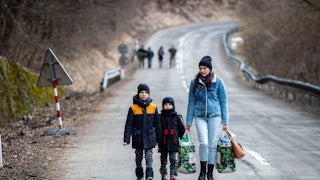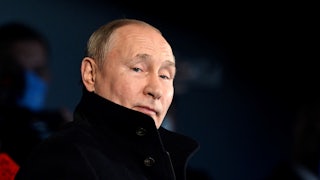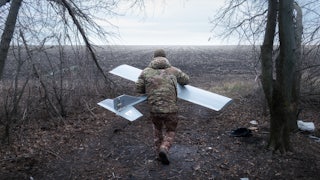Volodymyr Zelenskiy was direct about Western culpability. The symbol of his country’s courageous resistance to Russia’s bloody invasion of Ukraine, President Zelenskiy attacked NATO for rejecting his calls for a no-fly zone over Ukraine, in a video in early March. “All the people who will die starting from this day will also die because of you,” he said. “Is this the NATO we wanted?”
So far, U.S. and NATO leaders have staunchly refused Zelenskiy’s appeal. Russia’s ongoing, unrelenting devastation of Ukraine has led to increased calls to honor the request, however. On March 8, 27 diplomats, former Defense and State Department officials, and D.C. think tankers released an open letter calling for a “limited” no-fly zone. “A U.S.-NATO enforced No-Fly Zone to protect humanitarian corridors and additional military means for Ukrainian self-defense are desperately needed, and needed now,” they wrote. “NATO leaders should convey to Russian officials that they do not seek direct confrontation with Russian forces, but they must also make clear that they will not countenance Russian attacks on civilian areas.” The letter states that American and NATO aircraft would be deployed not in search of war but rather “to avert and deter” Russian bombardment of Ukraine’s civilians.
Evelyn Farkas, a Pentagon official in the Obama administration and one of the letter’s signatories, says that it came about after a group of experts discussing the issue privately decided to go public. They did so through the Atlantic Council, a D.C. think tank with ties to many of the signatories. “This is about not taking any options off the table; we’re looking to save lives in the short term,” Farkas said. Since Russia has violated the ceasefire it signed with Ukraine, there has to be a way of making sure civilians are protected: “We can’t just have a ceasefire, that has to be a way for us to enforce it.” The Russians fight dirty in war, she says, and they won’t act with moral decency unless they are forced.
But the Atlantic Council–organized plan depends on Russia obeying NATO’s instructions to avoid the area it has declared off-limits. There is no backup plan in case Russia disobeys. Even if NATO doesn’t seek direct confrontation with Russian forces—who are part of a military with the world’s most numerous nuclear weapons—we will be dramatically increasing our chances of getting one. Should Russian President Vladimir Putin send a bomber flying into the no-fly zone—or should one fly there accidentally or without authorization—NATO will be obliged to shoot it down, killing Russians directly when the country is at war. “I don’t see how you limit an operation which depends on another party not flying into your airspace,” said Olga Oliker, program director for Europe and Asia at the International Crisis Group. “You might have to take a Russian plane out, and then: Congratulations, it’s a war.” Experts at Princeton University conducted a simulation to determine how mutual escalation could lead to nuclear war between Russia and the United States, and they estimated that more than 90 million people would die in such an exchange.
Farkas has an answer to that claim. “Putin doesn’t want a war with NATO, it would be incredibly reckless for him to go war with NATO,” she said. And if his aircraft did enter NATO-controlled airspace, it would show that Russia is intent on starting a military conflict. “If they are that far gone, there is going to be war with NATO anyway,” she said. If Russia’s threshold for war with NATO is so low that establishing a no-fly zone is sufficient for it to fight, a conflict is inevitable. Implementing a no-fly zone would “absolutely not” be an escalatory act, Farkas added. “It’s a humanitarian act.”
NATO countries are already funneling arms to Ukraine, which one might say makes us a participant in the war. But Rachel Rizzo, senior fellow at the Atlantic Council, who is on the other side of the debate than some of her colleagues (she did not sign the letter), points out that such assistance is not new. “We’ve been sending arms to Ukraine for a long time,” she says. The U.S. delivered $60 million in arms to Ukraine last year alone. What is new is the speed and scale of assistance—when President Joe Biden approved a $350 million military aid package to Ukraine in late February, 70 percent of it was delivered in less than a week. But Rizzo observes that while Putin has called the West’s delivery of weapons to Ukraine a “hostile act,” he didn’t call it an act of war. Conversely, he said that a no-fly zone would make whoever implemented it a party to the conflict.
Even if a no-fly zone miraculously didn’t lead to direct war, it would significantly escalate a conflict that is already dangerously intensifying with no clear pathways for de-escalation. The sanctions are unprecedentedly harsh, turning Russia into the most sanctioned country in the world, and NATO countries continue to send arms to Ukraine. For all this, Russia shows no signs of abandoning its assault. “The West and Russia may now be entering into the terminal stages of an insecurity spiral—a series of mutually destabilizing choices—which could end in tragedy, producing a larger European conflagration even if it doesn’t go nuclear,” write Emma Ashford and Joshua Shrifinson in a new Foreign Affairs piece.
There are small hopeful signs that offer a potential way forward. “We are seeing some movement on de-escalation,” says Rizzo. Zelenskiy recently said that with NATO being unwilling to accept Ukraine as a member state at the current time, he might offer a “cooling down” period on pushing to join the alliance. In addition, he said there’s room to negotiate over Crimea, which Putin has claimed for Russia; and over Luhansk and Donetsk, which Russia’s leader says should be recognized as independent states. But Russia has also demanded that Ukraine end military action, which would mean abandoning the means for the robust self-defense it has displayed. Such a demand is unlikely to be heeded unless it’s done under duress.
Since the war is likely to continue for the foreseeable future, Russia will cause more human devastation in the coming days and probably weeks. The urge to find ways to protect Ukrainians will only grow. But any initiatives that depend on Russians following U.S. or NATO red lines stand a good chance of leading to more suffering. “I understand the desire and the logic [of a no-fly zone], it makes sense,” said Rizzo. “But it could lead to more death and more destruction for people on the ground.” Setting up any initiatives that depend on Russia following NATO’s declarations of humanitarian intent and observing our red lines are deeply risky endeavors. Said Ogla Oliker: “What happens if they don’t suddenly back down?”








